“It was the best of times; it was the worst of times,” – Charles Dickens, A Tale of Two Cities
Had Charles Dickens been a trucker in 2019, it would have been highly likely that he would have truncated this famous sentence to “It was the worst of times.” The freight recession that started in early 2019 has unfortunately continued, and for many has gotten worse. Profits have been almost non-existent for carriers of all sizes, and for a large portion of the carrier population, the entire year of business ended with absolutely nothing to show for it, not to mention cash injections from owners.
A dollar invested in any business should be worth more at the end of the year than at the beginning. That’s the whole point: to make money. The average North American motor carrier generated a negative return on its assets in 2019. That dollar invested at the beginning of the year was worth less, not more at the end of 12 months. For the average reader, without an education on the economics of trucking, the response to this statement would simply be that this is the risk of being in business: you take the good years, you take the bad years, and on balance, if you do the right things, you earn a profit. However, the problem with trucking is that there are two things to consider: the average long-term operating margins as a carrier (razor thin), as well as the massive risks faced by today’s carriers. Most industry articles typically focus on one or the other, but when you combine the two – rewards and risk – it presents a paradox. Why accept this level of risk for such paltry returns?
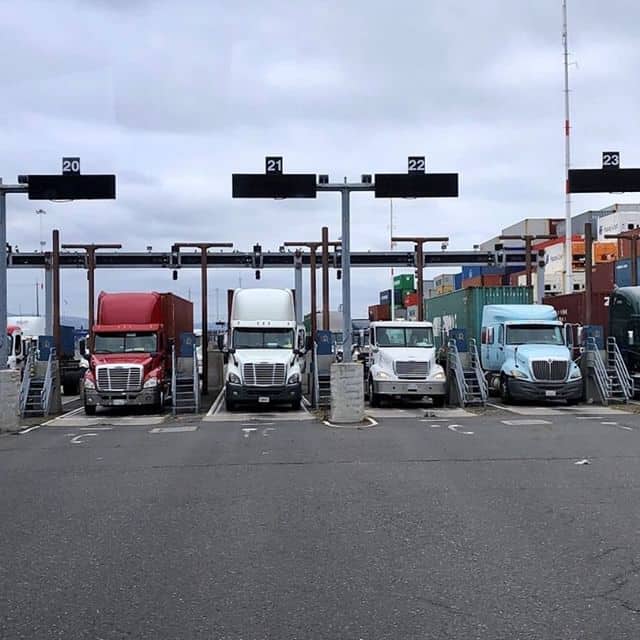
The reality is that trucking, like many other businesses (e.g. real estate), is leverage-friendly. It is very easy (over the long-term, not necessarily lately) to obtain credit to grow your business. Banks and lenders like physical assets; trucks are physical assets. This fact doesn’t guarantee success. Unlike some leverage-friendly businesses, trucking does not have a finite capacity. As a result, when times are good, capacity (trucks) enters the market. Incumbent carriers are just as guilty (if not more guilty) for the capacity problem.
This added capacity causes diminishing returns, even if it temporarily provides an increase in absolute profits for a carrier. The charts below illustrate, using empirical data, what the roller coaster of trucking profitability looks like.
The underlying data is gleaned from participants in the TCA Profitability Program (TPP), which is comprised of 238 trucking company profiles, of all sizes and modes, throughout North America. Although we do not have empirical data to confirm our hypothesis, we believe that the profit margins for the wider trucking community were significantly worse than described below. If that is correct, this is the best case. For those in the shipper community that are reading this, this is what transportation looks like on this side, this is the main street of trucking. For every Heartland Express, there are tens of thousands of ACME carriers that have done worse than the averages described below.
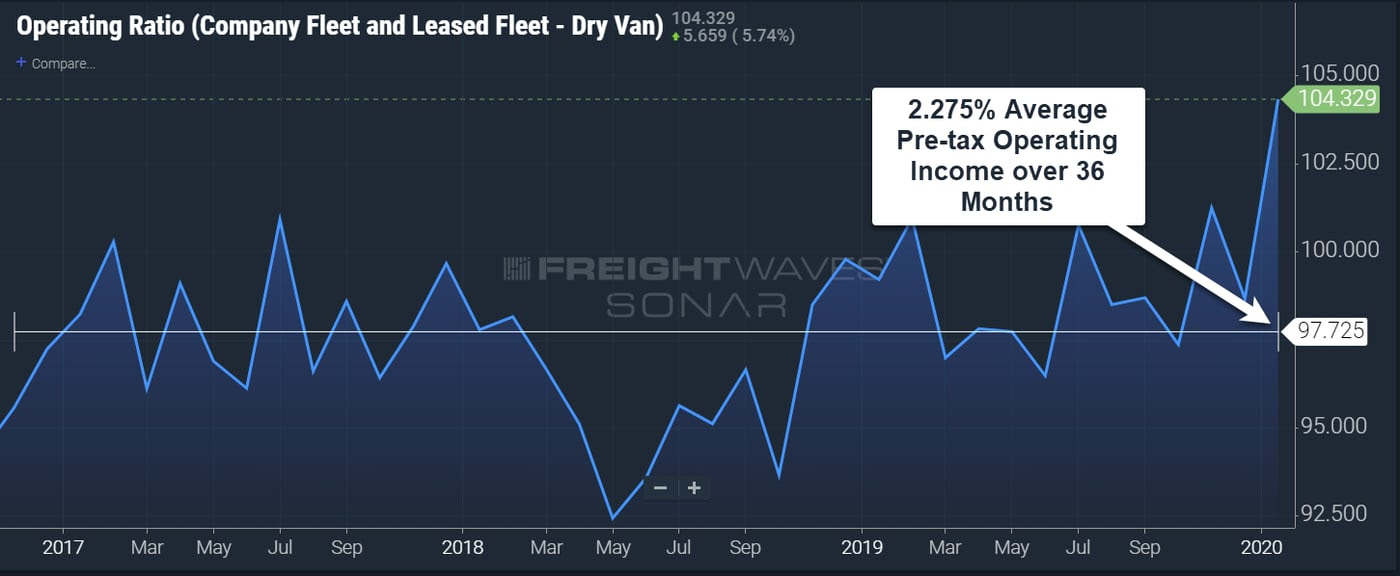
Source: FreightWaves SONAR
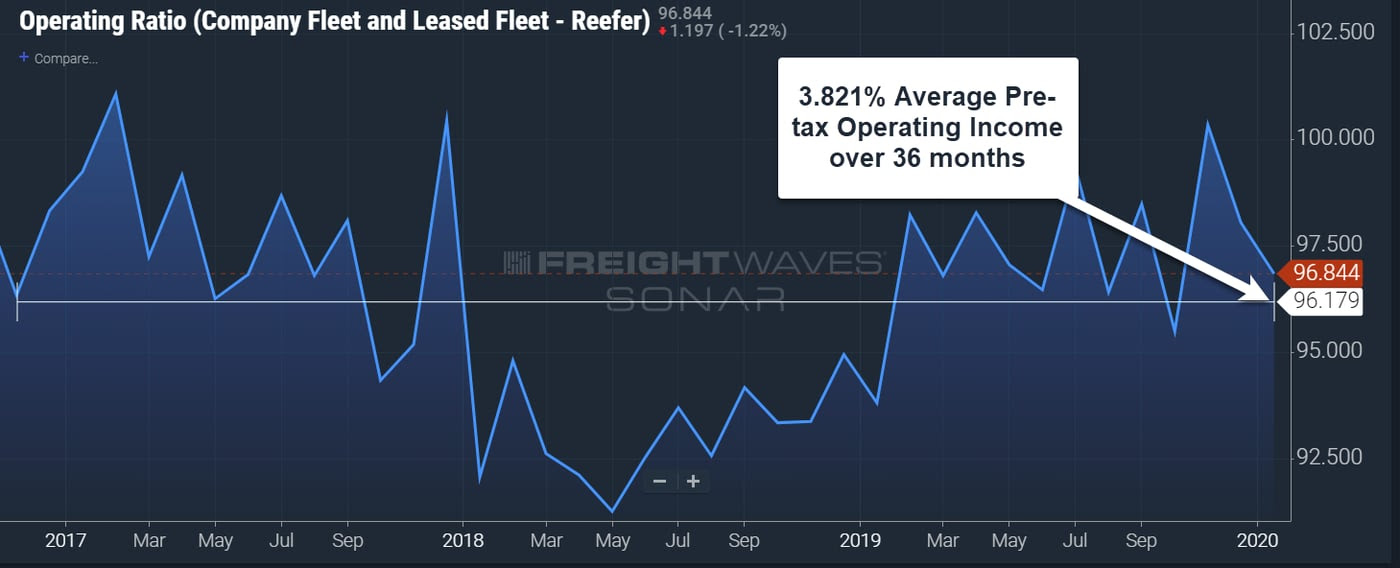
Source: FreightWaves SONAR
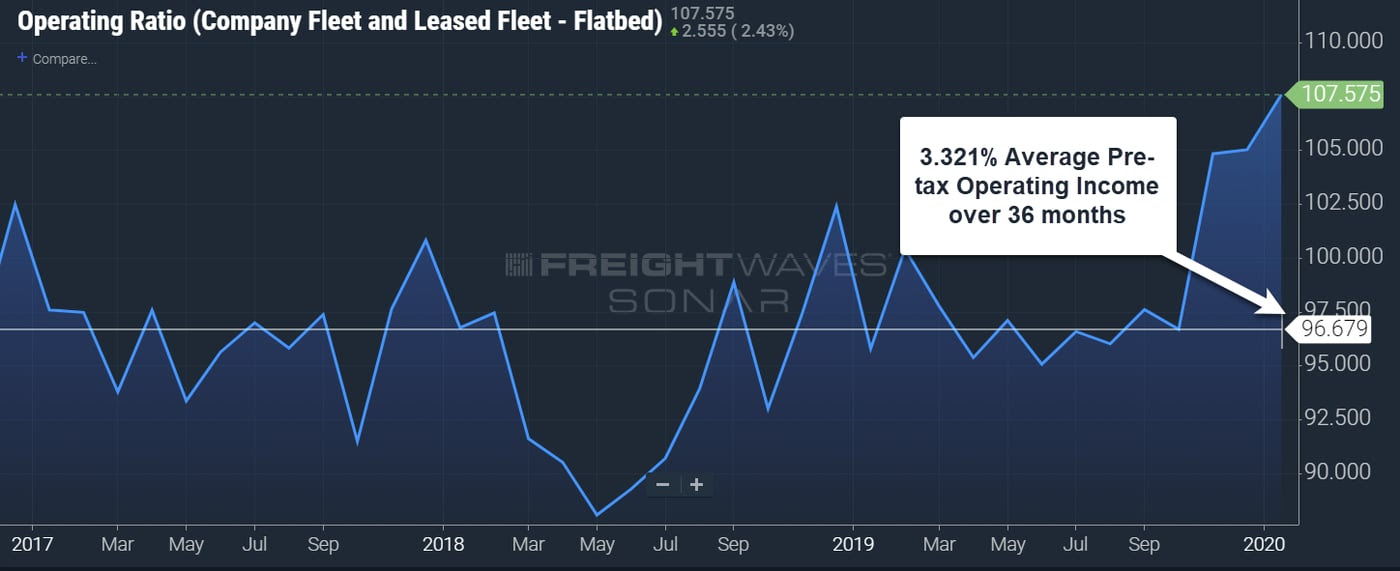
Source: FreightWaves SONAR
Now, let’s consider the risk side of the equation. For many, the first thing that comes to mind is the rising tide of litigation, and the number of nuclear verdicts being imposed on the industry. This is a trend of great concern. Carriers of all sizes and safety profiles are finding themselves on the wrong side of jury decisions at a growing rate. A decade of earnings can evaporate for both carriers and insurance companies with these kinds of judgements. When you combine these potential judgements with the difficult freight environment, most companies simply do not have the resources to assume liabilities from nuclear verdicts – or any jury verdict at all.
Nuclear verdicts, rising insurance rates, depressed used truck pricing, difficult macro and micro economics and countless other curve balls make it very difficult for a pragmatic business person to justify being a trucker. However, this is where the doom and gloom ends, and opportunities start.

Financial and operational literacy
After being part of the TCA Profitability Program for five years, I’ve been provided with the unique opportunity to observe, first-hand, the inner workings of a growing number of trucking companies, and gain insight from the leaders in each of those businesses. From this experience, I believe (you be the judge) I’ve been able to distill some of the traits of those companies that have achieved significantly better returns (profits) than the average carrier. Many of these top-performing companies had their best years in 2019! These traits are part of a common theme; these companies have treated the diseases that cause low returns, not just the symptoms.
The most viral disease in trucking is a lack of financial and operational literacy in this industry. All of today’s top trucking companies started with one truck. Trucking entrepreneurs are problem-solvers, and many have succeeded simply because they have the ability to put out fires rapidly, and sheer willpower to make some money along the way. However, once you start building a team, it can prove difficult to provide an education on the financial and operational realities of trucking – they are typically too busy putting out fires to take a step back, to identify a better way. A common trait among top-performing carriers is that they are very transparent in their operational and financial results, and are able to communicate these results in a way that anyone can comprehend. This, tied with line-item accountability and merit-based compensation, is a formula for success.

How does one start the journey towards both transparency and education? The first step is to eliminate metrics that many have difficulty understanding. At the top of the list is operating ratio (OR). I’ve had countless conversations with CFOs, new to the industry, who didn’t quite fully understand the components of an OR. The reason is that it’s not part of the normal language of businesses. Only three industries that I can think of use OR to communicate financial performance, as a default measure – trucking, railroads and insurance. Almost all other industries focus their attention on the inverse, operating income, as a percentage of revenue, and return on assets. If a CFO is asking what an OR is, it is highly likely that the vast majority of people in the company don’t know either. Operating ratio is also a subtle cloak for a stark fact – returns suck. To the average reader, what is more alarming, a 98.5% OR, or 1.5% operating income (or a 101.5% OR compared to -1.5%). I think the answer is clear.
Taking this one step further is translating the economics of trucking into a format that reinforces the challenges (and opportunities) in trucking in the language of business. One great method, which I feel very strongly about, is providing employees with a simplified profit and loss (P&L) statement. An example of this, which is available for all TPP members, is a P&L format using $1 of revenue as a starting point.
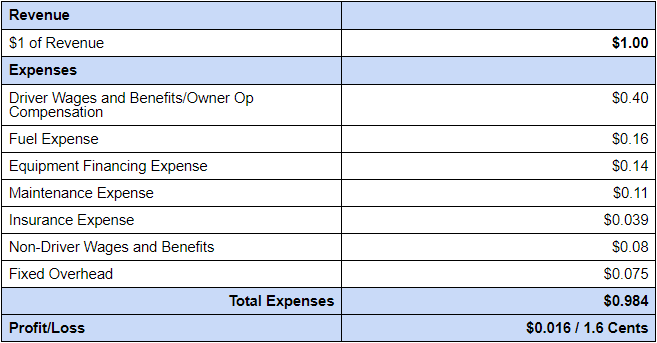
Using the above example, for every dollar of revenue generated, the carrier has kept just 1.6 cents. If you were to survey your employees using the standard question “For every $1 of revenue, how much (after all expenses) do we keep, in the form of profits?”, it would be a safe bet that the average response is going to be much greater than 1.6 cents (or 1.6% operating income). If your employees don’t know the stark realities of trucking, there is very little opportunity to influence front-line behavior, and daily decisions. If the employee believes that the company is keeping 30 cents on every dollar, it’s another safe bet to assume that he or she is rationalizing decisions that may have cost the business substantial sums.
This ties into the second trait of top-performing companies, which is really a timeless mantra.
A penny saved is a penny earned
Achieving larger relative rates per mile compared to the competition is extremely difficult. This is due to the fact that the trucking market is extremely efficient because of its pro-competitive aspects. As a result, shippers shouldn’t have any fears whether they are receiving the best possible price, within any given market. Instead of chasing top-line dollars, the best performers continually reinforce to their teams that every penny saved flows directly to the bottom line in the form of profit. This is a much better strategy than simply deciding to go after profit by adding more revenue (a strategy which is the underlying disease in trucking). Heartland Express, as a notable example, is widely known as a company that employs this strategy with great success (net margins of 25+%). This strategy can be distilled into a mantra that more carriers should repeat – Margin Before Truck Count. However, just talking about saving money is not the answer. People, the foundation of all businesses, need to take responsibility and be held accountable for the things they control.

Accountability and WIFM
Closing out the ‘top traits’ is accountability and merit-based compensation (WIFM – what’s in it for me). These are the final pieces of the puzzle that can eliminate the disease of market-level profitability in a trucking company (or any company). Once a team member can fully grasp the language of business (the financials) and the economics of trucking, only then will they be able to fully grasp both the implications of their role and tasks. It’s only natural, once armed with the data and education, for people to want to improve. A common method to expedite the improvement is to connect accountability for expenses and strategies with compensation, whether direct (bonuses) or indirect (trips, gift cards, company events, etc.).
In summary, top performers not only arm their employees (from the driver seat to the C-suite) with information on the health of the company, they also provide that information in a format that can be understood by anyone. These companies reinforce the importance of cost containment and discipline with respect to capital and time-consuming investment. Finally, they decide who (individual or group) is going to be held responsible for maintaining that discipline. In the end, if the formula works for your company, it will result in a more profitable enterprise, and eliminate the behaviors and people that have the opposite effect. You have treated the disease, instead of the symptom. Margin before truck count.












dbm2001
You forgot about the broker. Not only haven’t trucking rates risen as other wages have, but brokers are taking a much bigger chunk without assuming any of the risk. Brokers’ percentage they take should be capped.
Trucker Mike
Very pretty and sophisticated words and graphs used in this article. I’ve been running a small trucking business for 25 years, read the article, didn’t learn a DARN thing I didn’t already know! Thanks for wasting my time!
Look, it’s very simple to run a profitable trucking business. Charge significantly more money per mile than it costs to operate. Understand that there are 2 different types of expenses, fixed and variable. You need to understand first which of your expenses fall into which of those 2 categories. From that, you must then predict how many hours and miles per day your truck will operate and calculate the fixed and variable expenses you expect as a result of your operation. Depending on what and where you haul, the last question to ask yourself is, is their any seasonality changes I can expect throughout the year or is the work we do going to be constant throughout the year?
You also need to ask yourself how much profit do I need to keep AFTER taxes.
From that, you will determine how much you should charge per mile or per hour or BOTH. That all depends on how many miles per day on average your truck drives and how many hours does it take to move a load. Understand, things may change, so, you have to keep an eye on these numbers.
Understand too…if my truck is SITTING idle, its likely losing money.
Lastly, we must understand that freight rates vary based on supply and demand. We cannot always get X $ per mile or hour every where every time. We might make great money going into an area, but, the rates to get out are TERRIBLE or maybe even nonexistent and we have to deadhead long distance to get to the next paying load. Or, we might decide, the TIME it takes to run the low paying load is too great and therefore, we’re better of deadheading than taking the cheap freight.
It’s a game of averages.
One thing I have NEVER been able to understand is, how do owner operators make money working for mega carriers like JB Hunt, Schneider, etc who pay them $1.05 per mi plus FSC? It costs, for the most part, about $1 per mi for an OTR operator who runs 600+ mi per day. Those O/O are keeping $0.40 – $0.45 mi, but, then paying federal & state taxes plus an EXTRA 7.5% for the employer side of Social Security as well as paying for their own medical, dental, disability and work accident insurance policies.
How are they able to live?
They can easily find work paying $0.50 – $0.75 per mile PLUS benefits driving someone else’s truck and not worrying about or paying for ANY of the operational or ownership expenses of their own truck.
Can someone please explain that one? 25 years, I still don’t get it.
Driver
Video on how to apply for permits and your numbers and how to book a load for your truck . Is needed because a lot of people can speak English but can’t read very well
Trucker Mike
I’m sorry. If you dont know how to book a load or buy an OD/OW permit, you really shouldn’t own a truck.
This is part and parcel to the problems in the trucking industry the last few years.
Its WAY too easy to buy a truck, apply for authority or sign a lease with someone who has it…but, doing those steps doesnt insure you’ll ever make a dime in the trucking business and, in fact is why rates are too low. Too many clueless people in trucking who know one thing, how to agree to run a load for less $ than the previous guy. Problem is, you can only do so many loads losing $ before you are broke. But, for every clueless creature who climbed out from under a rock and successfully completed the app (despite their complete lack of knowledge or even understanding of the English language) there are 100’s more lined up behind them waiting for their turn to fail too.
And, the carriers and lenders dangling the keys to a shiny but abused truck are more than happy to give every one of those suckers their 15 min of fame.
Go learn English and get educated on the trucking business BEFORE jumping in head first.
Applying for permits and booking loads SHOULD be about as simple as putting fuel in your truck…maybe not PAYING for said fuel, but, the physical act of doing so.
John E Dodd
If trucking companies would stand there ground they could fix the problem but it’s like any competitive business there all afraid that Joy or Sally’s going to take there job so they take cheap freight and the big companies have did this for years trucks move more than 80% of freight if they would all work together and stid af against one another the problem could be fixed maybe not a hundred percent but there well always be problems.
Joe
This is all mambo jumbi, ifs ,buts, do this ,do that, you think people in trucking business do not know all this? How can you make a profit when today’s rates are below average , I’ve been in trucking industry for more than 15 years and I can tell you one thing , shippers do not give a shit they always look for the cheapest truck they could get ,I have heard rates that a ridiculously low , won’t even pay the diesel for the lane let alone hours, rentability you name it.
Many people I know quit , it just doesn’t pay off anymore .
For future truckers , do not buy bran new semi , let them sort it out .
Alric
It’s really quite simple. Charge higher rates. Stop giving away deliveries. Businesses need trucks. They either pay what the market demands or keep empty shelves.
Noble1 suggests SMART truck drivers should UNITE & collectively cut out the middlemen from picking truck driver pockets ! UNITE , CONQUER , & YOU'LL PROSPER ! IMHO
In other words the author of the article is suggesting to apply the KISS principle and to copy the success of others to reap the same reward as the successful ones reap . . Walmart certainly succeeded in such a way as did many others .
You can certainly do that , however, you won’t be a pioneer like Steinberg, Zellers, Apple , Microsoft ,Berkshire Hathaway , nor Ford , or Amazon etc .
To each their own .
Steve Strong
Article points to several important factors but seems to be missing the importance of:
1. Asset Utilization as a primary metric of operating cost (load ratio, dwell times at p/u & del’y, contractor waiting time between loads, contractor time away from home)
2. Partnerships with shippers to improve utilization and eliminate unnecessary administrative costs
3. Long term contracts at “fair” prices, cost visibility to shippers, sharing of utilization improvements (e.g., on time performance, speed of transit (e.g., teams), load/unload times, dedicated tours with high load factors, etc)